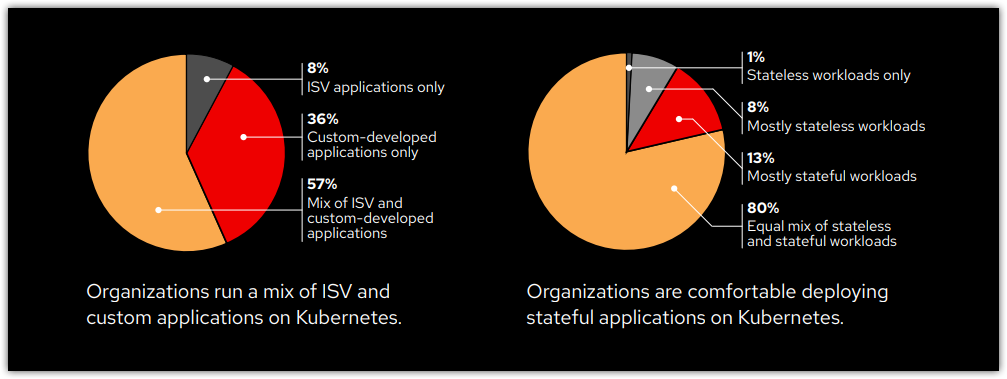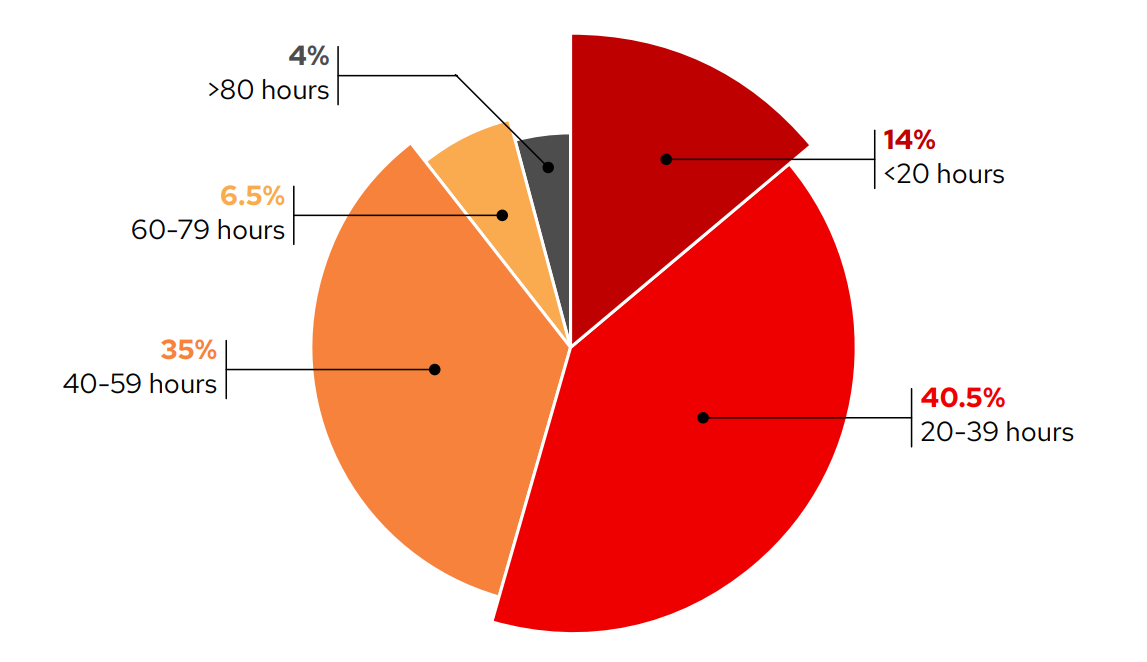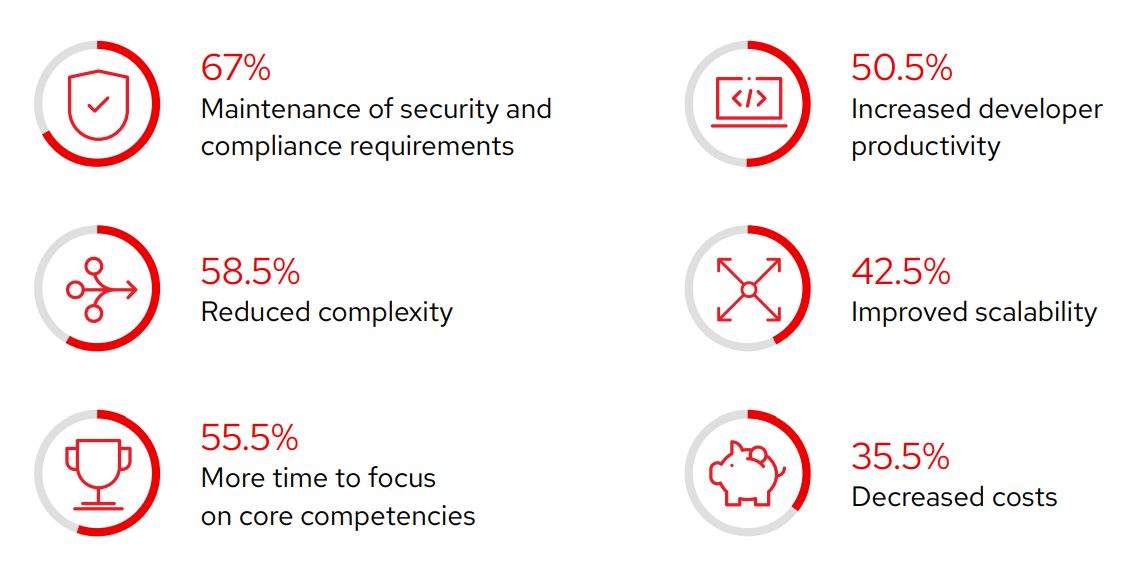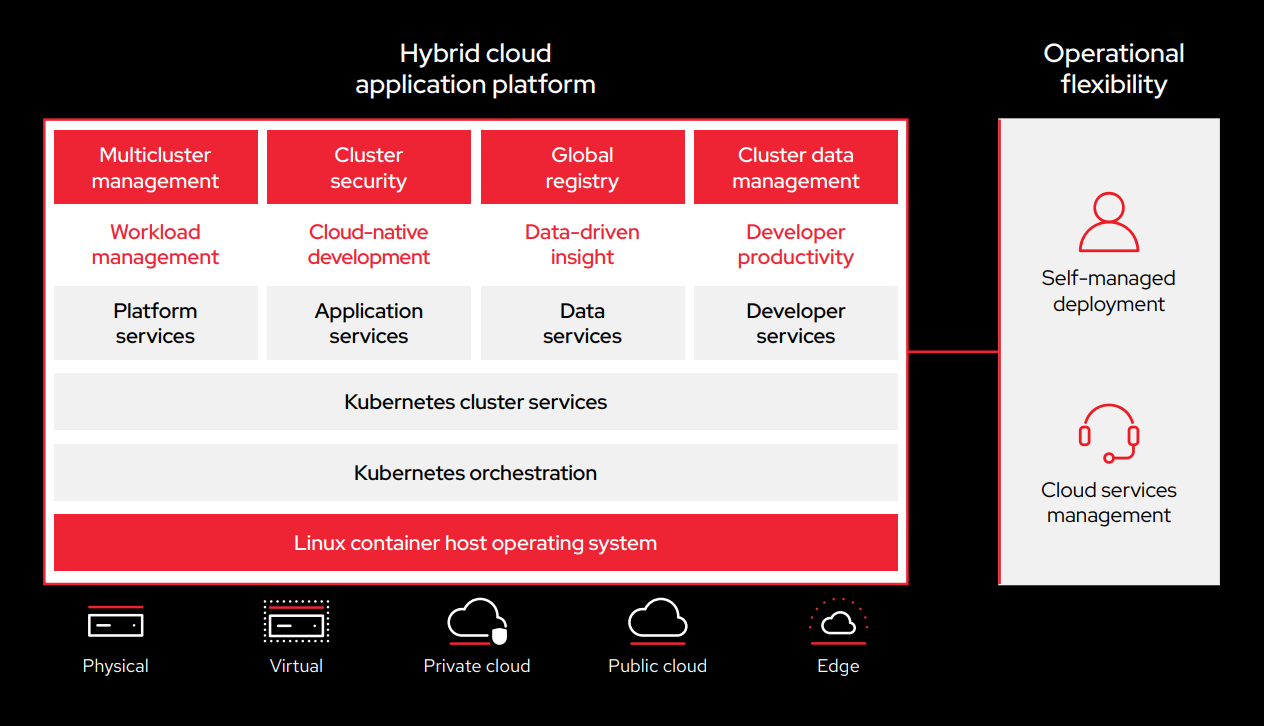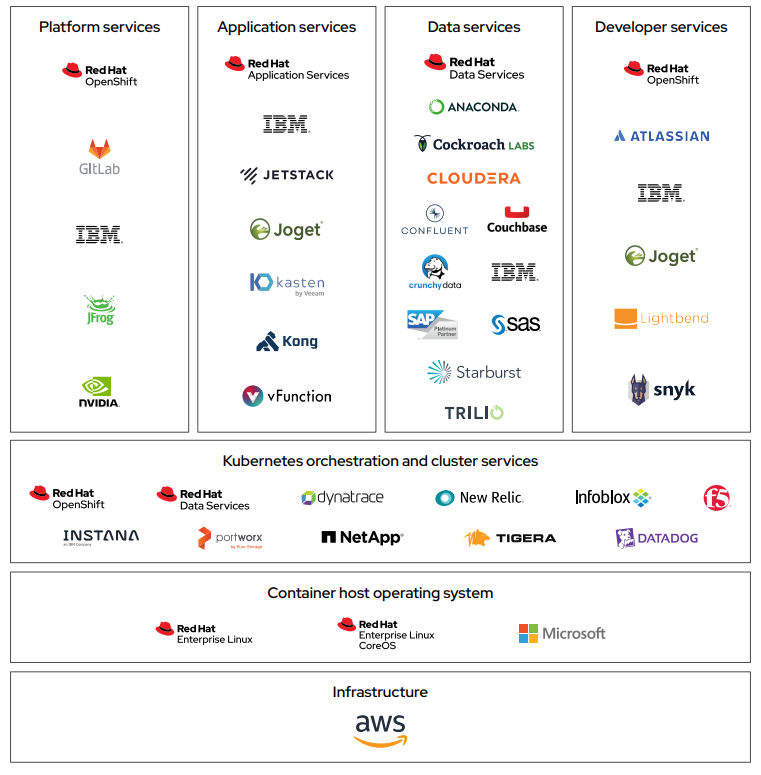Transform applications with Red Hat OpenShift Service on AWS
01 Executive summary
Unlock new business opportunities with application transformation, hybrid cloud platforms, and cloud services provided by trusted experts.
Across industries, organizations depend on applications to engage customers, partners, and employees; direct both internal and external business processes; and achieve business goals. The way you design, code, build, test, deploy, run, and manage these applications can greatly impact your organization’s ability to innovate and adapt.
By rapidly building, deploying, updating, and scaling applications in a security-focused, repeatable manner, across hybrid environments, you can unlock new possibilities for your business.
Hybrid cloud application platforms—like Red Hat® OpenShift® running on public cloud environments from providers like AWS or Microsoft Azure—play a key role in application modernization and transformation journeys. They provide flexibility and consistency, which are crucial for modernizing existing applications, developing new cloud-native applications, and delivering applications at scale across infrastructures.
Even so, deploying and maintaining app platforms takes time and resources. Many organizations don’t have the staff or skills to do the work without sacrificing other critical IT functions. A managed cloud service can help you rapidly build a hybrid cloud environment and focus on your business priorities, rather than administering your application platform.
Together, Red Hat and Amazon Web Services (AWS) deliver Red Hat OpenShift Service on AWS. Red Hat OpenShift Service on AWS is a jointly operated and supported turnkey application platform based on Kubernetes. With a focus on simplifying complex IT environments and cloud management, the platform eliminates the need to research, integrate, test, manage, and update underlying technologies yourself, saving you time and money. Red Hat and AWS have the expertise to be your trusted partner, provide the training your teams need, and support your journey to modern, cloud-native applications and operations.
Read on to discover current trends in application transformation and how you can modernize your business using a hybrid cloud application platform like Red Hat OpenShift Service on AWS.
Application transformation changes the way you develop, deploy, and manage applications to increase speed, efficiency, and agility.
02 Current trends in application transformation
Organizations use multiple technologies and methodologies to transform and modernize their applications.
Innovative applications are at the core of modern business. They connect organizations, partners, and customers to deliver valuable user experiences for all. Today, organizations are transforming their application portfolios to increase customer engagement, create differentiated services, improve operational efficiency, and compete in fast-changing markets. At the same time, organizations must also maintain their existing technology infrastructure and business processes. Maintaining legacy applications steals critical time and resources away from strategic and innovative projects.
An incremental, ongoing approach to application transformation is needed for success. While each organization’s journey is different, there are several common themes and initiatives.
Modernizing existing applications
Rehosting, replatforming, or refactoring your monolithic and n-tier business applications to run in cloud-native environments can help you adopt new technologies, improve security, speed innovation, and scale across datacenter and cloud infrastructures. Modernizing your IT environment and augmenting it with cloud and application services also provides more choice and flexibility for your developers. Support for frameworks like Quarkus, Node.js, Spring, ReactJS, Angular, and .NET Core lets developers make the most of their existing skills and knowledge in new environments.
Building cloud-native applications for containers and Kubernetes
Cloud-native approaches allow you to create modular, adaptable, microservices-based applications and data services. These applications and services can be delivered as standalone offerings or combined with existing applications, allowing you to release new capabilities faster. Embracing modern architecture and operational practices like serverless, application programming interfaces (APIs), event-driven architecture, and automated pipelines for continuous integration and delivery (CI/CD) also helps to simplify application development, delivery, and integration. Using these technologies, developers can focus on creating applications that deliver business value — without requiring detailed knowledge of the underlying infrastructure.
The importance of digital transformation
Modernizing and transforming your IT and applications can help your organization succeed in a fast-changing digital world.
92% of executives say that digital transformation will become more important in the next 12 months.1
Using AI/ML and data science to build intelligent applications
Adding data analytics, artificial intelligence and machine learning (AI/ML) capabilities into cloud-native applications can deliver more insight and value. You can analyze vast amounts of data generated in different ways and stored across multiple locations to understand and tailor customer interactions, business processes, service offerings, and more.
Integrating custom and third-party services
Combining applications and data services from in-house developments, independent software vendors (ISVs), and cloud service providers — like AWS — in a consistent manner across on-site, public cloud, and edge environments lets you create new offerings more rapidly.
Refocusing on innovation
Streamlining your IT operations can increase speed and efficiency. Cloud services can offload time-consuming platform and infrastructure management to dedicated third-party teams, so you can shift IT operations, security, and development team focus back to innovation, rather than administration.
Hybrid cloud application platforms based on containers and Kubernetes provide an ideal foundation for application transformation. These platforms can deliver the agility, consistency, efficiency, and scalability needed to build, deploy, run, and manage applications across datacenter, edge, and public cloud infrastructures. Combined with DevSecOps approaches, hybrid cloud application platforms can help you build a modern, reliable, and security-focused environment for both existing and new applications.
Even so, integrating these platforms into complex IT environments yourself can be difficult and time consuming. When moving to a container-based application platform, you must reassess how you perform common operations and manage security and compliance, while developing your staff’s container expertise.
Adopting a fully managed, cloud-based application platform can simplify deployment, streamline operations, and speed time to value compared to in-house solutions. Accordingly, 73.5% of organizations are outsourcing the implementation, maintenance, and optimization of their cloud platforms through cloud services, or plan to do so within the next year.2 With on-demand consumption models and expert guidance, your teams can focus on innovation and strategic projects that support your digital business initiatives. In fact, 55.5% of companies expect to have more time to focus on core competencies as a result of using cloud services.2
44% of organizations plan to invest in AI/ML technologies in the next 12-18 months.2
33% of organizations cite increased productivity and efficiency as a digital transformation goal.2
83.5% of technology leaders have already implemented a hybrid cloud strategy or plan to do so within the next year.2
Benefits of using Kubernetes and hybrid cloud for deploying applications
Pulse and Red Hat conducted two surveys of enterprise tech leaders to find out how they are using managed cloud services and Kubernetes to reduce the complexity of deploying applications across diverse IT landscapes.
The leaders cited several reasons they deploy their applications in containers and Kubernetes environments, including consistency, agility, portability, flexibility, and scalability. Below, we explore key findings from the Pulse surveys to illustrate how IT leaders are reducing complexity in their own environments.
Types of applications are being deployed with Kubernetes
Figure 1 shows the types of apps that are using containers and Kubernetes. This includes ISV and third-party software, stateful, and custom applications.
Top reasons IT leaders choose containers and Kubernetes
74% Consistency
73% Agility
55% Portability
54% Scalability
47% Flexibility
Time spent managing cloud platform upgrades and security patches
As you can see in Figure 2, operations teams spend a considerable amount of time each month managing upgrades and security patches for their hybrid cloud platforms.
To learn more, read the Pulse survey findings:
Expected benefits from using cloud services
Cloud services can free operations teams from cloud management tasks so they can focus on more interesting, high-value projects. Cloud services also deliver a variety of other benefits across your organization.
Types of workloads deployed in containers and Kubernetes environments
Organizations deploy many types of workloads in their containerized environments. Figure 3 shows some of the workloads that are best suited to containers and Kubernetes orchestration.
03 What you need to transform applications using cloud and Kubernetes
To effectively and efficiently build, deploy, and manage applications in containers and Kubernetes, you need a unified, integrated hybrid cloud application platform. Look for a platform that includes the following features and capabilities.
A consistent foundation for applications
A secure Linux® container host operating system and Kubernetes orchestration and cluster services—including automated installation, over-the-air updates, monitoring, and logging— provide consistent operations and life cycle management across your environment.
Cloud-native development and operations capabilities
Platform, application, data, and developer services—including CI/CD pipelines, integrated development environments (IDEs), programming languages, runtimes, build tools, observability capabilities, and API management— provide capabilities for efficiently and consistently building, deploying, and managing intelligent, cloud-native applications.
Integration with cloud services and third-party products
Simplified integration with cloud services and third-party products lets you take advantage of your preferred directories, management and automation platforms, databases, frameworks, AI/ML tools, and more, within your applications and operations.
Streamlined security and management capabilities
Consistent, unified security, management, and container image registry services simplify administration of large, distributed, hybrid cloud environments.
Operational flexibility and deployment options
A hybrid cloud platform that can be deployed in-house, in the cloud, and as a cloud service gives you the flexibility to choose where you run your applications and how much internal time and effort you devote to platform operations and management.
An ideal hybrid cloud application platform should incorporate all of the services and capabilities needed to effectively modernize existing applications and develop new cloud-native applications, while offering deployment flexibility and expert managed services.
04 Red Hat OpenShift Service on AWS: A consistent foundation for app transformation
Jointly engineered, operated, and supported by Red Hat and AWS, Red Hat OpenShift Service on AWS gives you a turnkey application platform based on production-grade components. This cloud service combines Red Hat OpenShift, AWS infrastructure, and an expert site reliability engineering (SRE) team to deliver a reliable foundation for innovation.
OpenShift Service on AWS offers more than just access to managed software and technologies. It provides a complete, full-stack environment with all necessary services and technologies, simple self-service options, and expert 24x7 support with a 99.95% availability service level agreement (SLA). Our SRE teams use proven best practices and extensive experience to build, operate, and maintain your OpenShift Service on AWS deployment.
Accessed on-demand from the AWS console, this service provides hourly billing on a single invoice for AWS deployments and integration with other AWS cloud-native services. And you can use your committed spend and discount programs for OpenShift Service on AWS.
With OpenShift Service on AWS, you can reduce support costs and increase operational efficiency while freeing your staff to innovate.
Why Red Hat OpenShift?
Red Hat OpenShift is a unified, security-focused hybrid cloud application platform for innovation. Powered by containers and Kubernetes, it provides a consistent foundation for modernizing existing applications, building cloud-native ones, streamlining development, adding intelligence to applications, and integrating third-party services.
Why AWS?
AWS is a high-performance, scalable, and comprehensive cloud platform that provides the availability, elasticity, and agility needed to run all of your applications. Automatic resource provisioning and retirement let you rapidly adapt to changing demand. Included security features and more than 50 compliance certifications and accreditations help you protect your organization and assets.
Ready-to-use platform
Simplify deployment and speed time to value with a ready-to-use native cloud service that provides a complete, integrated infrastructure software foundation, cloud-native application and data services, and security and management controls. Gain speed, efficiency, and scalability across a broad selection of technologies and applications using a platform that is trusted by industry innovators around the world.
Built-in developer tools
Access a large library of integrated, certified tools, development environments, and self-service capabilities that let developers code at speed. Improve efficiency and consistency throughout application life cycles with built-in CI/CD pipelines that contain a broad selection of supported technologies and workflows.
Self-service capabilities
Deliver a great user experience to increase employee satisfaction and retain developer talent. Developers can quickly, easily, and independently provision the resources they need without manual intervention from operations. Automated resource delivery lets developers start working faster.
Certified automation
Simplify application life cycle management with support for both Kubernetes Operators and Helm. Deploy and manage your preferred partner applications more easily and confidently with certified operators and Helm charts that encompass detailed vendor expertise. AWS offers a variety of operators for managing AWS services from within Red Hat OpenShift.
Hybrid cloud deployment
Develop, deploy, and manage applications where it makes the most sense. Provide a dependable, high-quality developer, operations, security, and application experience across hybrid environments. Red Hat OpenShift runs consistently in on-site datacenter and public, private, and hybrid cloud environments, so you can choose the right location for every project and application, and move them as needs change. This consistency also simplifies the migration of on-site workloads to AWS.
Always-on expert support and management
Streamline support costs and operations with included, expert 24x7 support. The Red Hat SRE team automates deployment and management of your Red Hat OpenShift clusters—including life cycle management, scaling, security patching, and incident response—so your staff can focus on application development and strategic initiatives. Reduce costly downtime and maintain reliability and security with managed upgrades, patching, and threat monitoring and remediation. Resolve issues quickly via a single path to support. Access extensive Kubernetes experience without retraining or moving existing staff or hiring new members. Speed deployment with migration planning assistance and managed cluster installation and verification.
99.5%of technology leaders say it is important to have developer tools integrated into their managed application platform.
Protect your business OpenShift Service on AWS is certified to and managed in compliance with key security standards, including:
- Payment Card Industry Data Security Standard (PCI DSS).
- System and Organization Controls (SOC) 2.
- International Organization for Standardization (ISO) 27001.
Flexible pricing options
Achieve the right balance of flexibility and cost for your organization with your choice of purchasing options. Simplify procurement with unified billing and purchase management through AWS. Use and pay only for the instances you need with on-demand pricing. Or take advantage of discounted pricing over a longer period of time with one- and three year reserved instance purchasing models. Red Hat OpenShift Service on AWS also fully qualifies for 100% of your spend with the AWS Enterprise Discount Program (EPD).
05 Maximize value with Red Hat OpenShift Service on AWS with flexible pricing and committed spending programs
Red Hat and AWS bring together everything you need to transform your applications.
Integrated portfolio and services
Build an ideal software foundation for all application transformation use cases using a complete, integrated portfolio of products and cloud services that work together reliably. Directly access more than 170 AWS cloud-native services for compute, database, analytics, machine learning, networking, mobile, and more, including:
- AWS Cloud Financial Management: Cloud cost management and optimization solutions
- AWS Cloud Databases: A set of fully managed, purpose-built databases, including Amazon RDS
- AWS Machine Learning services: A comprehensive set of AI/ML services, infrastructure, and resources
- AWS Management and Governance: A set of business management and governance control services, including Amazon CloudWatch
- AWS Networking and Content Delivery: A broad set of services— like Amazon CloudFront—for running workloads and delivering content over a reliable, security-focused network
- AWS Security, Identity, and Compliance: A broad set of identity and access management, threat detection, compliance, and network, application, and data protection services, including AWS Identity and Access Management, AWS Key Management Service, and AWS Secrets Manager
- AWS Cloud Storage: A portfolio of solutions—like Amazon S3 and Amazon Elastic File System—for storing, accessing, protecting, and analyzing your data
- Amazon Elastic Container Registry: A fully managed container registry with high-performance hosting
You can also take advantage of add-on managed application and data services like:
- Red Hat OpenShift API Management: A cloud service for deploying, monitoring, and controlling APIs throughout their life cycle
- Red Hat OpenShift Streams for Apache Kafka: A cloud service for creating, discovering, and connecting real-time data streams across locations
- Red Hat OpenShift Data Science: A cloud service for developing, training, and testing machine learning models
Simple migration and modernization with Red Hat OpenShift Service on AWS
Expert consulting services
Red Hat experts can help you modernize applications, migrate your workloads, and launch new app dev efforts with detailed guidance and practical tools that incorporate culture, process, and technology.
Validated patterns for edge computing and more
Deploy the applications your business relies on more rapidly with validated deployment patterns—at the network edge and elsewhere. These patterns are detailed, customizable deployments created for specific use cases and are based on real customer implementations.
Migration tools
Take advantage of Red Hat migration tools and the Konveyor community to help you plan your transformation journey and move your applications to Red Hat OpenShift.
Learn how Red Hat OpenShift cloud services can help you save time and money.
Read the brief
Certified partner ecosystem
Access a broad ecosystem of Red Hat certified ISV products to customize your environment with the application, data, AI/ML, developer, and IT operations services that work best for your organization.
Visit the Red Hat Ecosystem Catalog to browse certified software for OpenShift environments.
06 Achieve business outcomes across industries with Red Hat OpenShift and AWS cloud infrastructure
Combined with technologies from our partners, Red Hat OpenShift Service on AWS provides a foundation for complete solutions across industries.
Red Hat OpenShift Service on AWS for healthcare
Running Kubernetes on Red Hat OpenShift Service on AWS helps healthcare organizations:
- Increase clinic and hospital efficiency.
- Improve diagnostics.
Red Hat OpenShift Service on AWS is compliant with HIPAA (Health Insurance Portability and Accountability Act) requirements.
Red Hat OpenShift Service on AWS for financial services
Balance safety and innovation by running financial services and fintech apps on Red Hat OpenShift Service on AWS. This balanced approach can help financial services organizations:
- Detect fraud faster.
- Enhance customer services.
OpenShift Service on AWS helps our teams create the infrastructure they need, when they need it, to deliver the latest features and updates.
Red Hat OpenShift Service on AWS for manufacturing
Red Hat OpenShift supports industrial edge deployments that work with across your hybrid cloud. This helps manufacturers:
- Better predict equipment failures.
- Perform preventative maintenance.
To learn more, explore Red Hat’s approach to edge computing for manufacturing or see how multinational tech manufacturer Siemens uses Red Hat OpenShift for its modular, security-focused application platform.
Red Hat OpenShift Service on AWS for retail and online commerce
A unified application platform running on OpenShift and AWS can help retail and online commerce providers:
- Deliver multichannel experiences with less effort.
- Optimize IT costs and capacity.
[With Red Hat OpenShift cloud services], business gets features faster.” [4]
To explore how Red Hat OpenShift helps retailers achieve consistent, efficient operations, download The Total Economic Impact™ Of Red Hat OpenShift Cloud Services.
Red Hat OpenShift Service on AWS for telecommunications and service providers
Red Hat OpenShift Service on AWS provides reliability and scale for 5G networks and highly available services. Communication service provider (SP) networks run some of the most demanding workloads on the planet, and competition is fierce. Telecommunications and service providers who use Red Hat OpenShift and AWS can:
- Offer more valuable customer services.
- Optimize network operations.
With Red Hat OpenShift cloud services, we can develop features about 30–40% quicker with 25% reduction in costs compared with a public cloud provider container offering. [5]
To learn how to build highly available, cloud-native networks, download the IDC report: Using cloud-native architecture for communications SP networks.
Red Hat OpenShift Service on AWS for media and entertainment
Cloud-native applications and platforms are an ideal match for media and entertainment workloads. Red Hat OpenShift Service for AWS helps media organizations:
- Simplify content delivery across channels.
- Streamline content production.
[OpenShift Service on AWS] is actually perfect for our purposes since we want to focus on engineering development and deployment and service customers.
Watch the video to hear from Liftoff + Vungle about their experience using Red Hat OpenShift Service on AWS.
Red Hat OpenShift Service on AWS for energy
Like telecommunications and manufacturers, energy providers can take advantage of running Kubernetes-based apps on OpenShift and AWS. Red Hat OpenShift Service on AWS reduces complexity so energy providers can:
- Optimize field operations.
- Improve worker safety.
We don’t have to worry about continuously improving the platform or managing the underlying infrastructure or operations, freeing our team to fully focus on providing greater innovation and value to our customers.
Read the press release to learn more.
Red Hat OpenShift Service on AWS for automotive
Automotive companies need cloud-native platforms to build innovative products. In addition, in-vehicle operating systems and software have a high impact on consumers. Platforms like Red Hat OpenShift Service on AWS can help automotive manufacturers run secure and efficient apps that:
- Deliver autonomous driving technologies.
- Simplify and automate component testing.
Read the success story to learn how Audi AG reduced project time to market by up to 6 months with Red Hat OpenShift and AWS.
Red Hat OpenShift Service on AWS for logistics and transportation
Kubernetes and hyperscaler cloud offerings like Red Hat OpenShift Service on AWS can be used to build resilient, efficient logistics and transportation services. The scale and flexibility of cloud-native app platforms unlock high-value opportunities like:
- Optimizing scheduling operations.
- Streamlining supply chain management.
Read the success story to learn how a Swiss transportation group used Red Hat OpenShift and CI/CD practices to reduce work by 30%.
Red Hat OpenShift Service on AWS for government
High-performance computing, security, and consistency across platforms are valuable to government and public sector agencies of all types. Red Hat OpenShift Service on AWS has the power, scale, and stability necessary to run government workloads in a compliant and efficient manner. Key use cases for running apps on OpenShift and AWS include:
- Improving information management.
- Enhancing critical decision support.
Explore the success story to see how Taiwan’s research and academic institutions use Red Hat OpenShift for shared, high-performance computing resources.
07 Banfico delivers open banking with Red Hat OpenShift Service on AWS
Fintech startup Banfico provides Software-asa-Service (SaaS) solutions to its client banks in alignment with the United Kingdom (UK)’s Open Banking mandate. To deliver its services at the pace of market demand while maintaining compliance with the latest industry standards, Banfico sought to adopt a fully managed cloud application platform.
With Red Hat OpenShift Service on AWS, the company can rapidly build new applications with self-service provisioning and automated management processes and scale across cloud providers and regions. Built-in security certifications and automated compliance help Banfico protect its data and systems, as well as its clients’ sensitive data accessed through its applications and services.
Banfico has now migrated more than half of its banking clients to the new platform, which has allowed the company to:
- Expand open banking partnerships with an aggregated API platform.
- Create a scalable foundation for global growth.
- Reduce application delivery times from 25 minutes to near-instant deployment.
- Enhance security through built-in, automated compliance with industry standards.
Read the complete customer story to learn more.
08 Ready to get started with Red Hat OpenShift Service on AWS?
Red Hat and AWS simplify application modernization. With Red Hat OpenShift Service on AWS, you can take advantage of a unified foundation, integrated products and services, a large partner ecosystem, and expert support and services to transform your applications with less effort.
Visit Red Hat OpenShift Service on AWS on the web, the AWS Marketplace, or explore Red Hat’s dedicated learning paths to discover more.
Self-paced video learning paths:
Harvard Business Review, sponsored by Red Hat. “Digital Transformation Refocused: New Goals Require New Strategies,” May 2022.
Pulse, sponsored by Red Hat. “Cloud services help remove hybrid cloud complexity,” December 2021.
Pulse, sponsored by Red Hat. “State of workloads adoption on containers and Kubernetes,” November 2021.
Forrester Consulting study, commissioned by Red Hat. “The Total Economic Impact™ of Red Hat OpenShift Cloud Services,” January 2022.
IDC White Paper, sponsored by Red Hat. “Enterprises Accelerate Agility with Cloud Services,” August 2021. Doc. #US48032421.
With Red Hat OpenShift Service on AWS, we can not only deliver solutions aligned with the Open Banking mandate to our current customers, but have even picked up new business from banks that have been let down by other developers.

